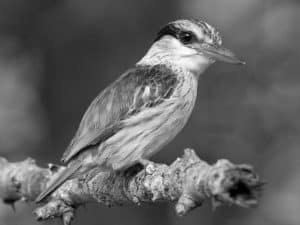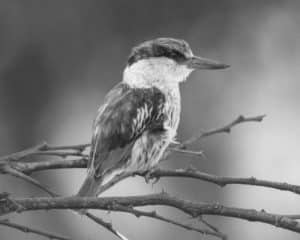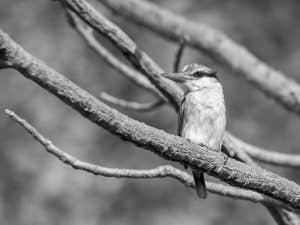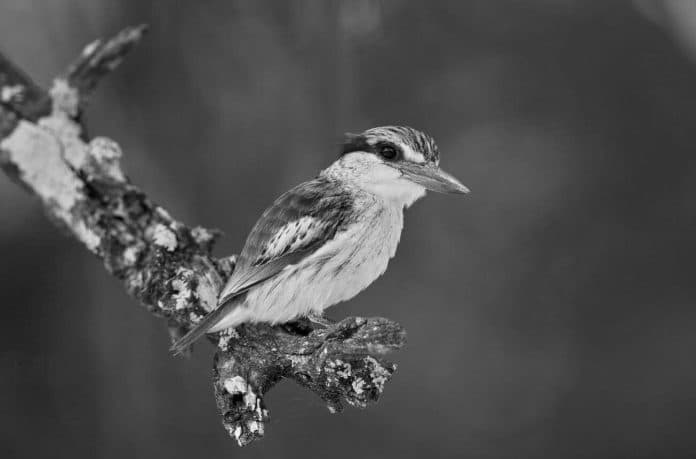Introduction to the Striped Kingfisher in Tanzania
Welcome to the world of the Striped Kingfisher in Tanzania, where these stunning birds grace the riverbanks with their presence. The Striped Kingfisher (Halcyon chelicuti) is a small but striking bird species found in various parts of Africa, including Tanzania. With its distinctive blue and white stripes, this bird is a sight to behold for birdwatchers and nature enthusiasts alike.

Tanzania, known for its diverse wildlife and stunning landscapes, is home to a rich bird population, and the Striped Kingfisher is a notable member of this avian community. Whether you’re a seasoned birdwatcher or a casual observer of nature’s beauty, learning about the Striped Kingfisher and its presence in Tanzania is sure to captivate your interest.
The Striped Kingfisher is a year-round resident in Tanzania, making it an integral part of the country’s ecosystem. As we delve into the habitat, distribution, physical characteristics, conservation efforts, and unique facts surrounding the Striped Kingfisher, you’ll gain a deeper understanding of these remarkable birds and the importance of preserving their natural environment.
Habitat and Distribution of the Striped Kingfisher
The Striped Kingfisher is widely distributed across sub-Saharan Africa, including Tanzania, where it inhabits a variety of habitats ranging from savannas and woodlands to riverine areas. These adaptable birds can be found near both freshwater and saltwater bodies, making them versatile in their choice of habitats.
In Tanzania, the Striped Kingfisher is commonly spotted along the riverbanks of major waterways such as the Rufiji River and the Great Ruaha River. These serene landscapes provide the perfect setting for the Striped Kingfisher to indulge in its natural hunting and nesting behaviors. Their ability to thrive in diverse habitats contributes to their widespread presence in Tanzania, delighting birdwatchers with their distinct beauty.
The distribution of the Striped Kingfisher extends beyond the mainland, as these birds can also be found in the coastal regions and surrounding islands of Tanzania. Their adaptability to coastal environments further underscores their resilience and ability to flourish in varying ecological settings. Whether you’re exploring the inland waterways or the coastal regions of Tanzania, keep an eye out for the striking presence of the Striped Kingfisher amidst its natural surroundings.
Physical Characteristics and Behaviors of the Striped Kingfisher
The Striped Kingfisher is characterized by its vibrant plumage, featuring a combination of deep blue and white stripes that adorn its body. Its compact size and distinctive coloration make it a visually appealing bird, especially when observed in its natural habitat. The males and females of this species exhibit similar plumage, with the male typically being slightly larger in size.
These agile hunters are known for their remarkable fishing skills, as they perch near water bodies and dive swiftly to catch small fish and aquatic invertebrates. Their keen eyesight and swift diving abilities make them well-suited for capturing prey in and around the water. Additionally, the Striped Kingfisher is known to construct its nests in earthen banks, using its sharp beak to excavate nesting tunnels where it lays its eggs.
During the breeding season, which typically occurs from September to December in Tanzania, these birds engage in courtship displays characterized by aerial pursuits and vocalizations. Observing these courtship behaviors provides a fascinating glimpse into the breeding rituals of the Striped Kingfisher, further enriching the birdwatching experience in Tanzania.
Conservation Efforts for the Striped Kingfisher in Tanzania
As with many species of birds and wildlife, the conservation of the Striped Kingfisher is of utmost importance to safeguard its population and natural habitats. In Tanzania, various conservation organizations and wildlife authorities are actively involved in monitoring and protecting the habitats where the Striped Kingfisher thrives.
Efforts to conserve the Striped Kingfisher in Tanzania encompass habitat preservation, research initiatives, and community engagement to raise awareness about the importance of protecting these birds and their ecosystems. By monitoring the population trends and ecological factors affecting the Striped Kingfisher, conservationists work towards implementing sustainable measures to ensure the well-being of these avian residents.
One of the key conservation strategies involves the establishment of protected areas and wildlife reserves that encompass the habitats critical to the Striped Kingfisher’s survival. These designated areas serve as havens for the birds, offering sanctuary from human encroachment and providing essential breeding and foraging grounds. Through collaborative efforts between governmental agencies, conservation groups, and local communities, the conservation landscape for the Striped Kingfisher continues to evolve with a focus on long-term sustainability.
Best Locations for Birdwatching the Striped Kingfisher in Tanzania

Tanzania’s diverse landscapes offer a multitude of opportunities for birdwatchers to observe the Striped Kingfisher in its natural habitat. Whether you’re exploring the expansive river systems, coastal regions, or inland woodlands, there are several prime locations where you can immerse yourself in the captivating world of the Striped Kingfisher.
The Rufiji River, with its meandering channels and lush riverine vegetation, provides an ideal setting for spotting the Striped Kingfisher as it perches along the water’s edge, scanning for potential prey. The tranquility of the riverbanks offers a serene backdrop for birdwatching, allowing enthusiasts to observe the Striped Kingfisher’s hunting and nesting behaviors with ease.
In the southern region of Tanzania, the Great Ruaha River and its surrounding woodlands are renowned for their diverse birdlife, including the striking presence of the Striped Kingfisher. Exploring the riverine forests and open plains adjacent to the river presents ample opportunities to encounter these birds in their natural environment, making it a favored destination for birdwatching enthusiasts.
For those seeking coastal birdwatching experiences, the islands and mangrove ecosystems along Tanzania’s coastline provide unique vantage points for observing the Striped Kingfisher in a distinct marine setting. The interplay between land and water creates an intriguing backdrop for birdwatching, offering a different perspective on the behavior and habitat preferences of these coastal avian residents.
Photography Tips for Capturing the Striped Kingfisher
Capturing the beauty of the Striped Kingfisher through photography requires a blend of patience, skill, and an understanding of the bird’s behaviors. Whether you’re an amateur photographer or a seasoned professional, these tips will help you enhance your chances of capturing stunning images of the Striped Kingfisher in Tanzania.
- Study the Behavior: Observing the hunting and perching patterns of the Striped Kingfisher can provide valuable insights into the best vantage points for photography. Pay attention to its favored perches and hunting grounds, and anticipate its movements to capture dynamic shots.
- Use Camouflage Techniques: To minimize disturbance to the birds and increase your chances of getting closer to them, consider using natural camouflage or blending into the surroundings to create a non-intrusive presence. This approach can lead to more natural and candid photography opportunities.
- Opt for Early Mornings or Late Afternoons: The soft, golden light during the early hours of the morning and the late afternoon can enhance the visual appeal of your photographs. Seek out the Striped Kingfisher during these times to benefit from favorable lighting conditions for your shots.
- Focus on Unique Behaviors: Look for opportunities to capture the Striped Kingfisher engaged in its natural behaviors, such as diving for prey, interacting with its mate, or tending to its nest. These moments can convey the bird’s character and vitality, adding depth to your photographic narrative.
- Respect Wildlife Ethics: While photographing the Striped Kingfisher, prioritize the well-being of the birds and their habitats. Maintain a respectful distance, avoid disrupting their activities, and adhere to ethical photography practices that prioritize the welfare of the subjects.
By applying these photography tips and approaching your subject with a sense of reverence for the natural environment, you can create visually stunning images that showcase the captivating beauty of the Striped Kingfisher in Tanzania.
Birdwatching Tours and Guides in Tanzania
For enthusiasts eager to embark on immersive birdwatching experiences in Tanzania, engaging the services of experienced guides and participating in specialized birdwatching tours can enhance the overall adventure. Tanzania’s diverse ecosystems and rich avian biodiversity set the stage for exceptional birdwatching opportunities, and knowledgeable guides can offer valuable insights and expertise to enrich your birdwatching endeavors.
Guided birdwatching tours often include visits to prime birding locations, such as national parks, wetlands, and riverine habitats, where the Striped Kingfisher and other avian species thrive. These tours are designed to cater to the needs of birdwatchers of all levels, providing educational experiences and memorable encounters with Tanzania’s diverse birdlife.
Experienced birdwatching guides possess a deep understanding of local bird species, their behaviors, and the ecological dynamics that shape their habitats. Their expertise in identifying bird calls, locating elusive species, and interpreting avian behaviors adds a layer of depth to the birdwatching excursion, allowing participants to gain a comprehensive understanding of the avian world in Tanzania.
In addition to guided tours, specialized birdwatching lodges and accommodations in Tanzania cater to the needs of birdwatchers, offering comfortable lodging, birding excursions, and opportunities to connect with fellow enthusiasts. These bird-friendly establishments provide a conducive environment for birdwatching-focused stays, ensuring that visitors can fully immerse themselves in the avian wonders of Tanzania.
Unique Facts and Folklore Surrounding the Striped Kingfisher

The Striped Kingfisher is steeped in unique facts and folklore that add to its mystique and cultural significance in Tanzania. As a revered figure in local traditions and a subject of fascination for bird enthusiasts, the Striped Kingfisher holds a special place in the cultural tapestry of the region.
In some Tanzanian communities, the Striped Kingfisher is associated with folklore and symbolism, often regarded as a symbol of good fortune and prosperity. Its striking appearance and distinctive hunting prowess have contributed to its portrayal in local stories and beliefs, reflecting the enduring allure of these birds in the cultural heritage of Tanzania.
Beyond folklore, the Striped Kingfisher’s ecological role as a predator of aquatic and terrestrial invertebrates contributes to the balance of local ecosystems, making it an integral part of the natural landscape. Its presence along the riverbanks and coastal areas serves as a symbol of the interconnectedness between wildlife and the environment, underscoring the importance of conservation efforts to protect these avian ambassadors of Tanzania’s natural heritage.
The Impact of Environmental Changes on the Striped Kingfisher Population
In the face of environmental changes and human activities that alter the landscapes where the Striped Kingfisher resides, the population dynamics and ecological balance of these birds are inevitably influenced. Factors such as habitat degradation, pollution, and climate variability pose significant challenges to the well-being of the Striped Kingfisher population in Tanzania.
The degradation of riverine habitats, often resulting from human encroachment and unsustainable land use practices, can disrupt the nesting sites and foraging grounds of the Striped Kingfisher, affecting their reproductive success and overall survival. Additionally, pollution from agricultural runoff and industrial activities can introduce harmful substances into the waterways, potentially impacting the availability of prey species vital to the Striped Kingfisher’s diet.
Climate variability, including shifts in rainfall patterns and temperature fluctuations, can further impact the habitats that the Striped Kingfisher relies on for sustenance and breeding. These environmental changes necessitate adaptive measures and conservation interventions to mitigate the adverse effects on the Striped Kingfisher population and its habitats in Tanzania.
By raising awareness about the ecological challenges facing the Striped Kingfisher and advocating for sustainable environmental practices, conservationists and wildlife enthusiasts play a crucial role in safeguarding the well-being of these birds and preserving the natural landscapes that sustain them.
Conclusion
The Striped Kingfisher in Tanzania embodies the beauty and resilience of Africa’s avian diversity, captivating observers with its vibrant plumage and captivating behaviors. As a year-round resident in Tanzania’s varied landscapes, these birds contribute to the rich tapestry of the country’s wildlife, offering glimpses of their hunting prowess and courtship rituals along the riverbanks and coastal regions.
Through conservation efforts, birdwatching experiences, and cultural appreciation, the Striped Kingfisher continues to thrive amidst the dynamic ecological landscapes of Tanzania. By understanding the habitat, distribution, behaviors, and conservation significance of these birds, we can foster a deeper appreciation for their presence and advocate for the protection of their natural environments.
Whether you’re drawn to the serenity of the Rufiji River, the allure of the Great Ruaha River, or the coastal marvels of Tanzania, the Striped Kingfisher invites you to witness its elegance and play a part in championing its conservation. As we embrace the interconnectedness of wildlife and environmental stewardship, the Striped Kingfisher stands as a symbol of beauty and resilience along Tanzanian riverbanks, inspiring admiration and advocacy for the preservation of its natural legacy.

































